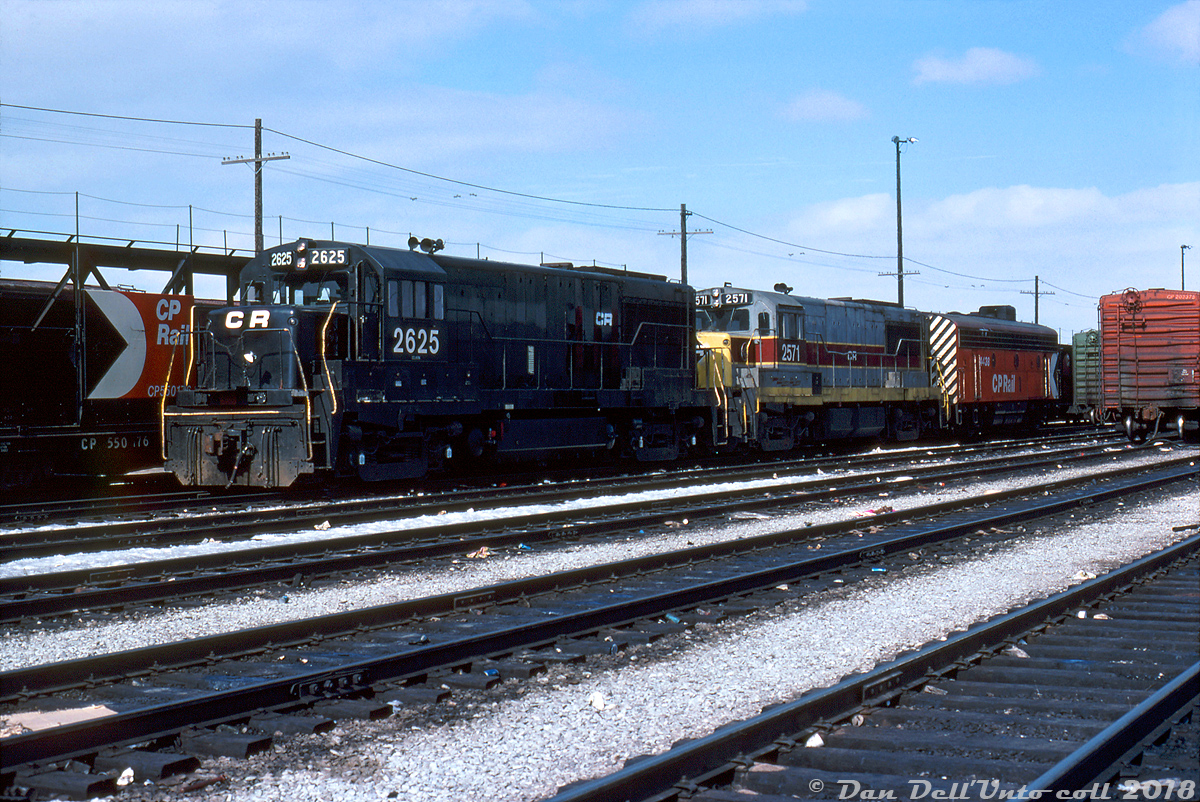|
Caption: Whose railway is this anyway? Power for the CP/TH&B "Starlight" (Toronto-Hamilton) sits inside CP's Toronto Yard awaiting the call to duty. One could often find CP, TH&B, NYC/PC/CR or a mix of power on this train, but today's 70's mega-mix lashup features Conrail U25B 2625 in patched Penn Central black, U25B 2571 still sporting Erie Lackawanna paint from its former bankrupt owner who was squeezed into Conrail the previous year, and CP F7B 4438 tacked on for good measure (looking back, one could often note the "token B-unit" tacked onto many different CP lashups of that era, including behind modern 6-axle units. Extra power was extra power I suppose).
These same two CR U-boats were noted in a photo taken a few weeks earlier at Stoney Creek trailing a TH&B Geep, so I would hazard a guess they found their way north on the "Kinnear" from Buffalo and stayed around for a bit. Maybe one of the usual suspects can chime in on how long PC/CR power stuck around on the TH&B/CP for.
Bill McArthur photo, Dan Dell'Unto collection.
|



The power for the Kinnear ( by this time, operating as BUCP and CPBU) unless something very unusual took place, was cycled in/out each 24 hour period. Of course it would be like any other terminal/terminal operation to have the same set of power “stuck” in that cycle.
And CP continued to utilize that power for quick Turns to Hamilton, either on Extras or the Starlight, while it laid over in Agincourt during the daytime.
Such US based motive power interlopers were a fabulous opportunity for Canadian modellers to justify something decorated other than CN or CP!
I have read elsewhere that under customs regulations at the time, any US-owned unit that was borrowed/leased for any length of time had to return to the US within 90 days, or else the Canadian railroad would have to pay duties on it. That would not matter for the power visiting on FT-1/TF-2/BUCP/CPBU, and a unit could (in theory) be assigned to the service multiple times if it was in Buffalo. The only units I have seen repeatedly (in photos) were the Canadian-built geeps 5820, 7429, 7430, and 7431.
What I have NOT seen is any 6-axle PC or Conrail power on this train. Is anyone aware of any 6-axle units being used, or any reason why they couldn’t be?
Jakob – yes and no.
Between the mid1960′s and the mid1980′s, the import requirements changed about 3 times.
In the 1960s and earlier, RR’s like NYC, Wabash, C&O, operating in Canada, could only utilize US-built engines for a maximum of 36 hours. This is the main explanation as to why each of them purchased engines built in Canada. Any other motive power was required to be out of the country ( with few exceptions) within 36 hours of arriving. This applied to day-to-day operations and not leased power. CN and CP leased many forms of US power in the 60s and 70s, and all of those terms were 90 days and longer. Naturally if an engine was broken down or derailed, there were provisions for time extensions. Otherwise, the only way they could use US-built engines on a near fulltime basis, was to pay import charges. (pre-HST days; C&O imported 3 different gp7′s for their Ontario operations).
When the revamped KINNEAR started in spring 1966, the 2 main participants (TH&B and NYC) assigned their own, Canadian-built engines to it. Naturally when something broke down, or the schedules got way off kilter, other power was needed.
With NYC being strictly a 4-axle railroad, there were no larger engines that could have been used. However, after the PC creation, it didn’t take long for 6-axles to show up on this run. [ I would have to look in my notes from approx. 1971 to find the first instance].
So it wasn’t a case of the larger units not being used, it was a case, up until Feb1968, of them not being on the roster.
Thanks Bruce. The only 6-axle units I’m aware of are PC E-units that came over on the passenger train before it was converted to RDCs in 1970. Otherwise I’ve been surprised that I haven’t seen any sign of a PC or early Conrail 6-axle units, when one might think they would be helpful in climbing the escarpment on the return trip. Big units were certainly used on the very flat CASO!
It makes more sense that it’s simply a matter of no photos of a 6-axle PC/CR unit turning up (yet).
I’m hoping someone can prove that a CR SDP45 made it to Toronto…
Jakob – E-units are not 6 axles in that sense, the center axle is an idler.
Six axles on the Caso began showing up, in my notes anyway, approx mid1969. And, it was only on PC trains, as C&O could not use 6-axles on their own lines in Ontario. Hence they would not be seen on trackage rights trains.
My first note for 6-axles on the Kinnear was in January 1972, an SD45 and an SD35. But that did not start a trend, as 4 axles remained the preferred for months afterward.
Keep in mind, when the NYC/PC power went bad order, CP usually had to provide enough power to get the train to at least Niagara Yard (NY). It was never anything “posh” like SD40s or M630s, always RS-units or FA/FB’s.